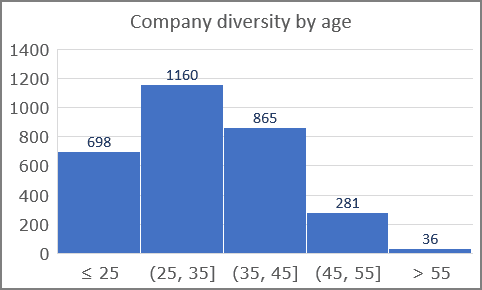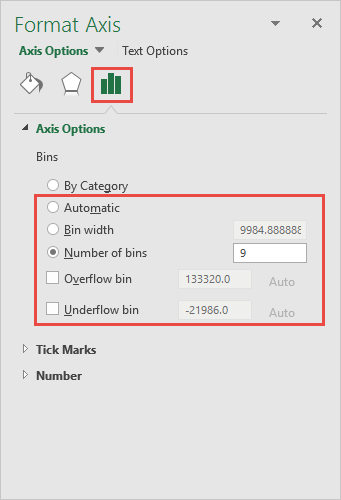

At a given point, you can either specify Bin Width or Number of Bins (not both). For example, if I specify 7 here, it will create a chart as shown below. It will automatically create a chart with that many bins.

Number of Bins: Here you can specify how many bins you want.Bin Width: Here you can define how big the bin should be.You can change this by using the ‘Bin Width/Number of Bins’ options (covered below). For example, in our chart, it decided that there should be four bins. Automatic: This option automatically decides what bins to create in the Histogram.It isn’t helpful in our example as all our categories are different (Student 1, Student 2, Student3, and so on.) For example, if you have sales data for items such as Printer, Laptop, Mouse, and Scanner, and you want to know the total sales of each of these items, you can use the By Category option. This could be useful when you have repetitions in categories and you want to know the sum or count of the categories. By Category: This option is used when you have text categories.Here are some of the things you can do to customize this histogram chart: This will open a pane on the right with all the relevant axis options. Now you can customize this chart by right-clicking on the vertical axis and selecting Format Axis. The above steps would insert a histogram chart based on your data set (as shown below). In the HIstogram group, click on the Histogram chart icon.In the Charts group, click on the ‘Insert Static Chart’ option.Here are the steps to create a Histogram chart in Excel 2016: It has the marks (out of 100) of 40 students in a subject. Suppose you have a dataset as shown below. In case you’re using Excel 2013 or prior versions, check out the next two sections (on creating histograms using Data Analysis Toopack or Frequency formula). Creating a Histogram using FREQUENCY FunctionĮxcel 2016 got a new addition in the charts section where a histogram chart was added as an inbuilt chart.Creating a Histogram using Data Analysis Toolpak.

Creating a Histogram Using Data Analysis Tool pack.
#Draw histogram in excel 2016 how to
Let’s see how to make a Histogram in Excel. If you’re using Excel 2013, 2010 or prior versions (and even in Excel 2016), you can create a histogram using Data Analysis Toolpack or by using the FREQUENCY function (covered later in this tutorial).If you’re using Excel 2016, there is an in-built histogram chart option that you can use.There are different ways you can create a histogram in Excel: You can easily create a histogram and see how many students scored less than 35, how many were between 35-50, how many between 50-60 and so on.

#Draw histogram in excel 2016 series
The histogram condenses a data series into an easily interpreted visual by taking many data points and grouping them into logical ranges or bins.Ī simple example of a histogram is the distribution of marks scored in a subject. It’s a column chart that shows the frequency of the occurrence of a variable in the specified range.Īccording to Investopedia, a Histogram is a graphical representation, similar to a bar chart in structure, that organizes a group of data points into user-specified ranges. Watch Video – 3 Ways to Create a Histogram Chart in ExcelĪ histogram is a common data analysis tool in the business world.


 0 kommentar(er)
0 kommentar(er)
